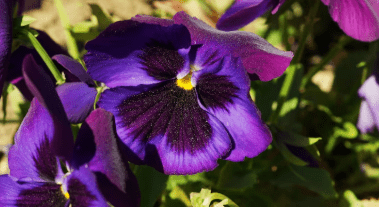
Viola odorata
Latin name: Viola odorata
Short name: Viol-o
Common name: Sweet Violet | English Violet | Wood Violet | Garden Violet | Florist's Violet
Primary miasm: Psoric Secondary miasm(s): Sycotic
Kingdom: Plants
Family: Violaceae
- Symptomatology
- Remedy Information
- Differentiation & Application
Viola odorata is a small, fragrant, perennial herb native to Europe and parts of Asia. It is known for its deeply scented purple flowers, which have long been associated with calming and cooling properties. In homeopathy, a tincture is made from the fresh flowering plant and is noted for its action on neuralgias, particularly of the upper extremities, respiratory conditions, and children’s ailments, including coughs and nervous system disturbances.
Historically used in herbal medicine for treating respiratory complaints (such as whooping cough and bronchitis), as a mild sedative, anti-inflammatory, and in perfumes. It has demulcent, expectorant, and soothing properties.
Conducted primarily in the 19th century and clinically confirmed by Dr. Burt and others. Though not widely proved in Hahnemannian tradition, the remedy has a clearly established clinical picture, particularly in nervous coughs and right-sided shoulder affections.
- Right upper extremity – especially shoulder joint, deltoid, and arm
- Nervous system – functional nervous disorders, excitability, twitching
- Respiratory system – spasmodic, dry, irritating coughs, especially in children
- Eyes and ears – tension and auditory disturbance
- Muscles and joints – tension, stiffness, and pain, especially in scapular and cervical regions
- Children’s complaints – cough, excitability, earaches, sleep issues
- Pressure
- Lying on painful part
- Gentle motion
- Warm applications
- Rest in a quiet environment
- After sleep
- Warmth, particularly of bed or clothing
- Cold air or draughts
- Change in weather, especially to cold and damp
- Nighttime (especially cough and shoulder pain)
- Lying on back
- Mental exertion or nervous excitement
- Coughing or deep inspiration
- Slight touch, though pressure relieves
- Spongia tosta – Dry, barking cough with anxiety; but more hoarseness and thyroid affinity
- Causticum – Right shoulder paralysis with dry cough, but more weakness than spasmodic pain
- Bryonia alba – Painful shoulder with immobility, worse from slightest motion
- Phosphorus – Right-sided chest symptoms with dry cough, but more burning and thirst
- Cimicifuga – Neuralgic pains, especially in neck and shoulders, but often with uterine symptoms
- Drosera – Spasmodic coughs, but more violent and worse after midnight
- Complementary: Bryonia, Causticum
- Follows well: Belladonna, Aconite
- Antidotes: Nux vomica, Camphora
- Inimical: None well established
Viola odorata is a remedy of sensitive nerves, spasmodic afflictions, and functional neuralgia. Its primary keynote lies in drawing, cramping pains of the right shoulder, coupled with dry, irritating coughs, especially in nervous children. The essence of the remedy is tension—be it muscular, nervous, or emotional—exaggerated by cold, night, and overexertion, and alleviated by warmth, pressure, and sleep. It suits individuals with a delicate, highly reactive constitution, where symptoms seem disproportionate to pathology, yet are deeply felt and affect the entire system.
- Excellent in dry, tickling coughs of children, worse at night
- Especially useful in neuralgic right shoulder pain, better from pressure
- Consider for nervous twitching and restlessness in sensitive patients
- Can assist in nervous headaches and minor insomnia from overexcitation
- Low to medium potencies (6C–30C) frequently used; 200C occasionally indicated in chronic neuralgia
Mind
- Nervousness, children
- Restlessness, night
- Anxiety, evening
Respiration
- Cough, dry, night
- Oppression, lying down
- Suffocation, sensation of
Extremities
- Pain, shoulder, right
- Twitching, sleep, during
- Neuralgia, arm, shoulder
Sleep
- Disturbed, from cough
- Dreams, frightful
- Sleep, unrefreshing
Generalities
- Better pressure
- Worse cold air
- Worse night
- John Henry Clarke – Dictionary of Practical Materia Medica: Provided details on shoulder affections and cough
- William Boericke – Pocket Manual of Homoeopathic Materia Medica: Gave indications for respiratory and nervous symptoms
- C. Hering – Guiding Symptoms of Our Materia Medica: Confirmed key modalities and neuralgic patterns
- E.M. Hale – New Remedies: Offered clinical confirmations in shoulder neuralgia and children’s cough
- T.F. Allen – Encyclopedia of Pure Materia Medica: Supplemented proving data and cough-related symptoms
